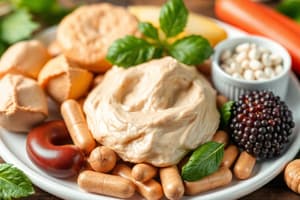Podcast
Questions and Answers
What percentage of protein supplements typically contains inactives such as Maltodextrin?
What percentage of protein supplements typically contains inactives such as Maltodextrin?
- 40-70% (correct)
- 30-50%
- 10-30%
- 70-90%
Which macro-nutrient is primarily responsible for tissue growth and repair?
Which macro-nutrient is primarily responsible for tissue growth and repair?
- Fiber
- Carbohydrate
- Fat
- Protein (correct)
What role do vitamins and minerals play in the body?
What role do vitamins and minerals play in the body?
- Act as co-enzymes and co-factors (correct)
- Serve as primary energy sources
- Provide immediate energy
- Facilitate digestion of proteins
What type of nutrient is water classified as in the context provided?
What type of nutrient is water classified as in the context provided?
What is the primary function of carbohydrates in the diet?
What is the primary function of carbohydrates in the diet?
What is the minimum daily water intake recommended for an adult?
What is the minimum daily water intake recommended for an adult?
What are the products of protein digestion in the stomach before they reach the small intestine?
What are the products of protein digestion in the stomach before they reach the small intestine?
Which statement regarding essential amino acids is correct?
Which statement regarding essential amino acids is correct?
What role does the liver play in amino acid synthesis?
What role does the liver play in amino acid synthesis?
What is required for protein synthesis in the body?
What is required for protein synthesis in the body?
Study Notes
Protein Composition in Supplements
- Protein supplements comprise 40-70% of inactive ingredients, such as maltodextrin, which has a glycemic index (GI) of 106-136.
- Major components of protein powders include amino acids, soluble fiber, vitamins, magnesium, selenium, and astaxanthin.
Nutrient Categories
- Macro-nutrients: Include carbohydrates, proteins, and fats- composed of rice, wheat (carbohydrates), eggs and dal (protein), and butter and oil (fats).
- Micro-nutrients: Include vitamins and minerals primarily derived from fruits and vegetables, which are vital for body functions.
Protein Digestion Process
- Dietary proteins are broken down into peptides in the stomach by enzymes, then further into amino acids in the small intestine for absorption.
- Absorbed amino acids are transported to the liver to synthesize various body proteins, such as antibodies.
Essential and Non-essential Amino Acids
- There are nine essential amino acids (EAA) that must be sourced from food.
- The liver synthesizes six conditionally essential amino acids (CEAA) and non-essential amino acids (NEAA) from EAAs.
- Protein synthesis requires all nine EAAs to be present in adequate proportions.
Specific Amino Acids and Their Functions
- BCAAs: Promote muscle protein synthesis; beneficial for preventing lean muscle loss.
- Lysine: Key for carnitine synthesis, aiding energy production.
- Threonine: Important for mucin formation and antibody production.
- Arginine: Contributes to nitric oxide synthesis, regulating blood pressure.
- Glycine: Crucial for collagen synthesis, promoting tissue health.
- Cysteine & Taurine: Play roles in antioxidant protection and cardiovascular health.
- Astaxanthin: A potent antioxidant with protective effects against various health issues.
Antioxidants and Oxidative Stress Management
- Free radicals generated during oxidation can lead to oxidative stress, linked to age-related disorders.
- Glutathione (GSH) and glutathione peroxidase (GPx) act as primary antioxidants; GSH is synthesized from glutamine, cysteine, and glycine.
- Selenium boosts the production of GPx, enhancing antioxidant defenses in the body.
- Astaxanthin, derived from freshwater algae, exhibits superior antioxidant properties, being much more potent than Vitamin E and Vitamin C.
Importance of Water and Fiber
- Water constitutes about 60% of adult body weight and is essential for nutrient absorption and hydration. Daily intake should be around 3-4 liters.
- RMD (soluble fiber) aids digestion, lowers cholesterol, and helps maintain blood sugar levels; beneficial for conditions like diabetes and cardiovascular diseases.
Nutrient Bioavailability
- Amino acids from protein sources vary in their percentage utilized for protein synthesis.
- AminoRich XP: 100% utilized; Whole eggs: 99%; Meat, chicken, and fish: 82%; Whey, soy, and nuts: 75% or less.
Comparison with Other Protein Sources
- Many protein powders contain 40-70% inactive ingredients, including sugars, and take 3-8 hours for absorption, highlighting the efficiency of AminoRich XP.
Studying That Suits You
Use AI to generate personalized quizzes and flashcards to suit your learning preferences.
Related Documents
Description
This quiz explores the composition of protein supplements, focusing on the percentage of inactive ingredients, including Maltodextrin. It also delves into the various macro and micronutrients that are included in these products, such as amino acids, vitamins, and minerals.




